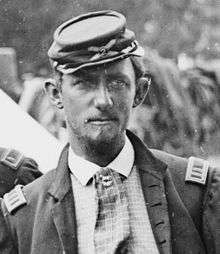Alexander Cummings McWhorter Pennington Jr.
Alexander Cummings McWhorter Pennington Jr. (January 8, 1838 – November 30, 1917), was an artillery officer and brigadier general in the United States Army and a veteran of both the American Civil War and Spanish–American War.
Alexander Cummings McWhorter Pennington Jr. | |
|---|---|
 Alexander C.M. Pennington Jr., 1862. detail of photo by James F. Gibson. Library of Congress | |
| Born | January 8, 1838 Newark, New Jersey |
| Died | November 30, 1917 (aged 79) New York City, New York |
| Place of burial | |
| Allegiance | United States of America Union |
| Service/ | United States Army Union Army |
| Years of service | 1860–1899 |
| Rank | |
| Commands held | Battery A, 2nd U.S. Artillery Battery M, 2nd U.S. Artillery 3rd New Jersey Volunteer Cavalry 1st Brigade, 3rd Division, Cavalry Corps 2nd U.S. Artillery |
| Battles/wars | American Civil War Spanish–American War |
| Relations | Alexander Cummings McWhorter Pennington (father) |
Early life and career
Pennington was born in Newark, New Jersey, the son of Congressman Alexander Cummings McWhorter Pennington (1810–1867), the second cousin of New Jersey Governor and Speaker of the U.S. House of Representatives William Pennington (1796–1862), and the grandnephew of New Jersey Governor William Sandford Pennington (1757–1826).
He attended the United States Military Academy at West Point, during the brief period in the 1850s when the curriculum was expanded to five years. He graduated 18th in the Class of 1860. Appointed as a brevet second lieutenant on graduation day, July 1, 1860, he received his commission February 1, 1861, and was permanently assigned to the 2nd U.S. Artillery. There, he gained experience under the tutelage of Captain John C. Tidball, serving under him in Battery A.
Civil War
Battery A, 2nd U.S. Artillery, was the first unit assigned and equipped as horse artillery, and served throughout the war with the U.S. Horse Artillery Brigade, in the Army of the Potomac. Pennington began the war as the lead (right) section chief in Battery A, and was cited for gallantry in the Peninsula Campaign. He was awarded brevet promotions to captain (June 9, 1863) for actions at Beverly Ford, Virginia, and major (July 3, 1863) for actions at Gettysburg.
He commanded Battery M, 2nd U.S. Artillery in 1863 and 1864, also with the Horse Artillery. Promoted to captain in the regular army, Pennington took a volunteer commission as the colonel of the 3rd New Jersey Volunteer Cavalry on October 1, 1864. Cited again for gallantry at Cedar Creek (October 19, 1864), he was awarded a brevet promotion to lieutenant colonel. He commanded the 3rd New Jersey Cavalry through the end of the war, and mustered out of the volunteer service on August 1, 1865. For his distinguished service throughout the war, he was awarded brevet promotions to colonel in the regular army and brigadier general of volunteers. Pennington was nominated for appointment to the grade of brevet brigadier general of volunteers, to rank from July 15, 1865, by President Andrew Johnson on January 13, 1866, and the United States Senate confirmed the appointment on March 12, 1866.[1]
After the war, Pennington became a First Class Companion of the Military Order of the Loyal Legion of the United States, a military society for Union officers.
Postbellum career
After the war, Pennington returned to service in the regular army, serving as a captain in the 1st U.S. Artillery. He transferred to the 4th U.S. Artillery with his promotion to major (November 8, 1882), and remained there as lieutenant colonel (November 28, 1892) until October 1896. He returned to his original regiment, the 2nd U.S. Artillery, where he served as its colonel and commander, from October 29, 1896, to the outbreak of hostilities between the United States and Spain.
Along with his responsibilities as commander of the 2nd Artillery, Pennington served as the commanding officer of Fort Adams in Newport, Rhode Island, from December 1, 1896, to May 24, 1898. In this position Pennington was the senior Army officer in New England and commanded all coastal fortifications from Maine to Connecticut.
During the Spanish–American War, Pennington served as a brigadier general of volunteers from May 4, 1898, to April 12, 1899, and earned his final promotion, to brigadier general in the Regular Army, one day before his retirement, on October 17, 1899.
Pennington retired to New Jersey, where he lived through the beginning of the First World War. Pennington died in New York City and is buried in West Point Cemetery. His wife, Clara Miller French Pennington, daughter of The Rev. John W. French, died in 1915.
Family
Alexander and Clara Pennington were the parents of at least five children, including Annie, the wife of Adelbert Cronkhite, and Edith, the second wife of Charles Treat.
Notes
- Eicher, John H., and David J. Eicher, Civil War High Commands. Stanford: Stanford University Press, 2001. ISBN 978-0-8047-3641-1. p. 754.
References
- Eicher, John H., and Eicher, David J., Civil War High Commands, Stanford University Press, 2001, ISBN 978-0-8047-3641-1.
- Heitman, Francis B. Historical Register and Dictionary of the United States Army, From its Organization, September 29, 1789, to March 2, 1903. Washington, D.C.: Government Printing Office, 1903.
- Library of Congress, Prints & Photographs Division, Washington, D.C.
- Register of Graduates and Former Cadets of the United States Military Academy. West Point, NY: West Point Alumni Foundation, Inc., 1970.
- Simpson, Lt. W. A., History of the Second Regiment of Artillery, 1900.
- U.S. War Department. The War of the Rebellion: A Compilation of the Official Records of the Union and Confederate Armies. Washington, D.C.: Government Printing Office, 1894.
External links
- "Generals and Brevets: Photographs of General Officers of the Civil War". Archived from the original on 2008-02-08. Retrieved 2008-02-08.CS1 maint: BOT: original-url status unknown (link) .